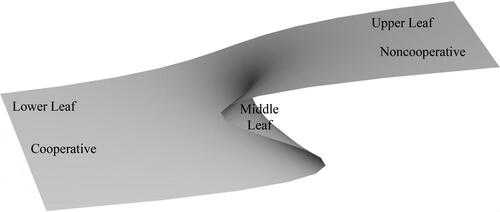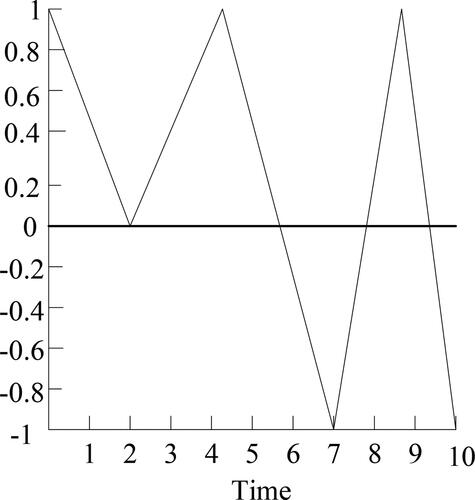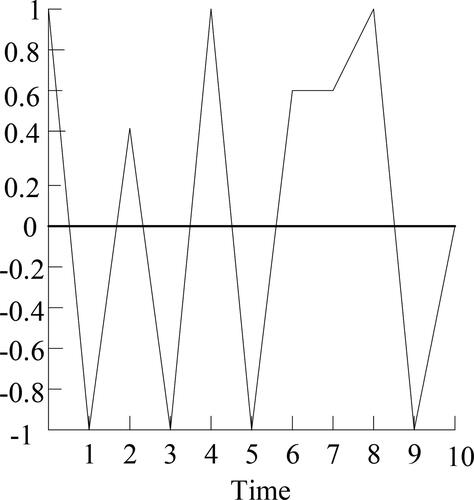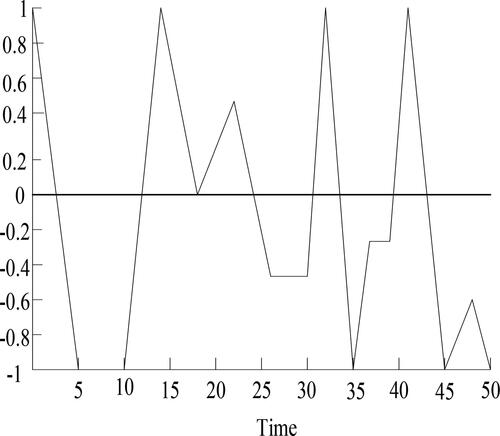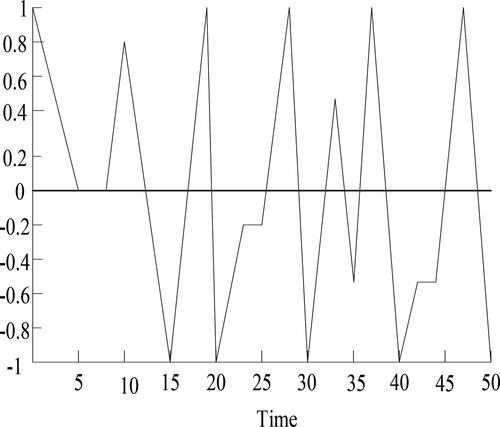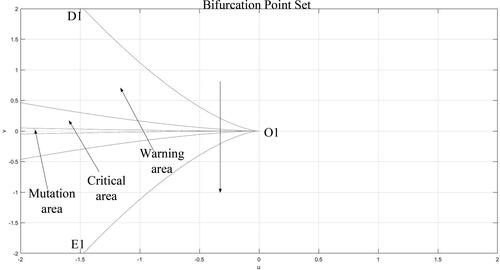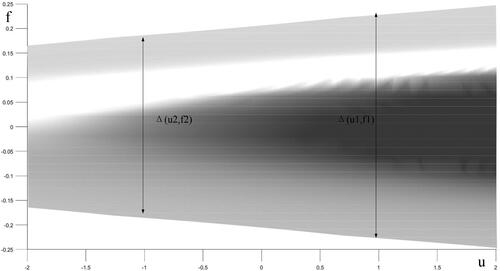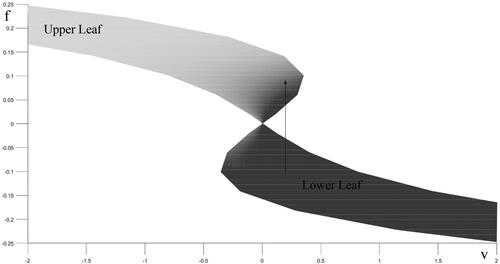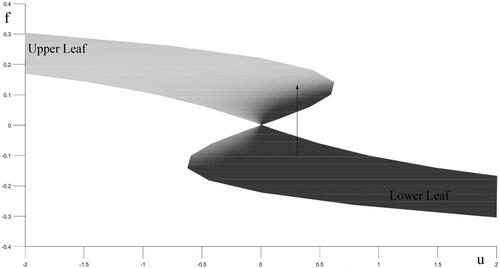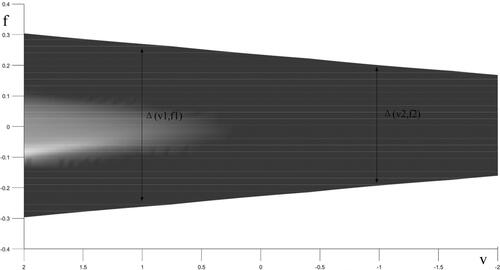 ?Mathematical formulae have been encoded as MathML and are displayed in this HTML version using MathJax in order to improve their display. Uncheck the box to turn MathJax off. This feature requires Javascript. Click on a formula to zoom.
?Mathematical formulae have been encoded as MathML and are displayed in this HTML version using MathJax in order to improve their display. Uncheck the box to turn MathJax off. This feature requires Javascript. Click on a formula to zoom.Abstract
This article introduces a new model, the catastrophe model of intellectual property cooperation behavior. The purpose of the model is to analyze the evolutionary track of intellectual property cooperation behavior. After providing a general of catastrophe mechanism of intellectual property cooperation behavior and introducing stochastic catastrophe theory, this article offers a catastrophe model of intellectual property cooperation behavior. And then, based on the survey data of high-tech enterprises, the model parameters were given by introducing the qualitative simulation algorithm. The results demonstrate that intellectual property cooperation is composed of a cooperation strategic planning stage, cooperation system formation stage, cooperation system working stage, and cooperation profit distribution stage. Under the influence of control variables, the intellectual property cooperation behavior will appear catastrophic near the set of bifurcation points. Most previous studies on intellectual property cooperation have disregarded the characteristic of the sudden changes in cooperation behavior. Therefore, this article offers an integrated catastrophe model and explains the nature of intellectual property cooperation behavior.
JEL CODES:
1. Introduction
Intellectual property cooperation is an important way for enterprises to expand the utility of intellectual property resources and facilitate knowledge innovation (Teece, Citation2000). For example, Apple Inc. obtained permission from Microsoft Corporation’s Exchange ActiveSync to fix problems with synchronizing emails, calendars, and contacts in 1st generation iPhones. In the age of the knowledge economy, intellectual property cooperation behavior is vital for enterprises to survive and develop. To be more precise, intellectual property cooperation behavior has important theoretical and practical value for promoting knowledge innovation. Scholars have recognized and acknowledged that intellectual property is critical for promoting knowledge innovation and technology innovation (Tang et al., Citation2014). Related studies on intellectual property have shifted from intellectual property protection to intellectual property cooperation. For instance, Samson et al. (Citation2005) proposed that intellectual property protection is important, but it is more important to transform intellectual property into real productivity to facilitate knowledge innovation. Guo et al. (Citation2018) also stated that intellectual property cooperation enables cooperation partners to share intellectual property-centered knowledge resources and then achieve knowledge innovation. Based on the above, intellectual property cooperation can be defined as behavior in which cooperation partners integrate knowledge resources and exchange knowledge information through exchange, coordination, and cooperation based on intellectual property resources, to realize knowledge innovation and share innovation outcomes with cooperation partners. Practices show that intellectual property cooperation has the remarkable characteristics of enhancing the knowledge-advantage of cooperation partners and increasing the social capital value of cooperation partners (Gao et al., Citation2016). With the increasing prominence of intellectual property cooperation advantages, many studies have found that it is difficult to maintain the stability of intellectual property cooperation among enterprises. According to a survey, regardless of the form of cooperation, only 40% of enterprises can sustain more than four years of partnership, and 50% of enterprises easily encounter difficult problems in the first two years of cooperation (Yang et al., Citation2018). The process of intellectual property cooperation inevitably involves the ownership and profit distribution of intellectual property, which affects the stability of cooperation. In view of this phenomenon, scholars have explained the instability and causes of intellectual property cooperation from different perspectives. For instance, Wang (Citation2017) proposed that the factors that influence knowledge sharing are the fault-tolerant attitudes of enterprises, the complementarities of mutual knowledge, the degree of mutual trust, and the cost of knowledge-sharing failure. Based on evolutionary game theory, Yang et al. (Citation2018) analyzed government-industry-university-research of intellectual property cooperation behavior and its influencing factors from market mechanisms and administrative supervision mechanisms. The results provide some references for the study of enterprises' intellectual property cooperation behavior. Zhang et al. (Citation2020) analyzed the effects of the quantity of knowledge, the sharing ability coefficient, the sharing reward coefficient, the sharing penalty coefficient, the sharing risk coefficient, and the sharing cost coefficient on knowledge sharing behavior.
The above research results are the foundation that allows enterprises to promote the stable development of intellectual property cooperation. However, the existing literature still has some limitations, most of the existing research results ignore the sudden change in intellectual property cooperation behavior, few literatures pay attention to the abruptness and randomness of intellectual property cooperation behavior, try to explore the evolutionary track of enterprises' intellectual property cooperation behavior by stochastic catastrophe theory. Meanwhile, the process and stage of intellectual property cooperation are not detailed enough, most of the existing literature considers intellectual property cooperation as a whole, ignoring the characteristics and complexity of intellectual property cooperation in each stage, it is prone to the ‘black box’ problem of intellectual property cooperation, which is not conducive to the partners involved to reach cooperation intentions. Intellectual property cooperation is a dynamic process in which various variables interact. When the interaction reaches a certain state, it will promote the realization of innovation outcomes. The process accords with the characteristics of the sudden change of stochastic catastrophe theory. Moreover, before the realization of innovation outcomes, the intellectual property cooperation system was in an equilibrium state. With the investment of intellectual property resources and the influence of the external environment, the variables will make intellectual property cooperation reach a certain critical state. When the variables change slightly, the equilibrium state of the intellectual property cooperation system will be destroyed. The process is in line with the stochastic characteristics of stochastic catastrophe theory; therefore, this article uses stochastic catastrophe theory to construct a catastrophe model of intellectual property cooperation behavior.
Intellectual property cooperation behavior is a dynamic process that changes over time Considering the lack of the variable time
in stochastic catastrophe theory, we cannot accurately describe the evolutionary direction of intellectual property cooperation behavior. This article introduces the qualitative simulation algorithm (QSIM algorithm), which describes the value of variables and the relationship among variables through a specific set of symbols. In terms of the initial qualitative state, we can predict all possible behaviors based on the relevant rules (Kuipers, Citation1986). QSIM is widely used in knowledge sharing and knowledge transfer. For example, Wang's (Citation2014) research has provided accurate scientific information for simulating change in different periods of individual knowledge-sharing performance levels by use of the QSIM algorithm. Fang et al. (Citation2019) adopted a qualitative simulation algorithm based on QSIM theory improvement to explore the optimal combination of strategies that knowledge transfer performance reaches a relatively high point for the initial state of different stages. The above studies highlight the ability of the QSIM algorithm to predict knowledge-sharing and knowledge transfer behaviors in different time periods and initial qualitative states.
The main contribution of this article is that we use catastrophe theory to explain the nonlinear evolution characteristics of intellectual property cooperation, describe the evolutionary path of intellectual property cooperation behavior, it provides theoretical support for all partners involved in intellectual property cooperation to adopt different cooperation strategies. Meanwhile, the catastrophe model constructed in this article has strong applicability; the model can be used to effectively predict and modify the evolutionary path of intellectual property behavior by corporate stakeholders.
The rest of this article is organized as follows: The section ‘Catastrophe Model of Intellectual Property Cooperation Behavior’ constructs a catastrophic model of intellectual property cooperation behavior. The section ‘Application of QSIM Algorithm’ proposes the QSIM algorithm for describing the variables. The section ‘Empirical Study and Comparative analysis’ focuses on the numerical simulation of intellectual property cooperation behavior and gives a comparative analysis with traditional methods. The section ‘Discussions and Implications’ discusses the obtained simulation results and provides suggestions. The section ‘Conclusions’ presents the conclusion of this article.
2. Catastrophe model of intellectual property cooperation behavior
2.1. Analysis of catastrophe mechanism
Under the background of open innovation, all cooperation behavior will reach a stable and orderly state through interactive activities among enterprises. Yao et al. (Citation2020) argued that stable and orderly states include cooperative behavior and noncooperative behavior. Based on previous research, this article divides enterprises' intellectual property cooperation behavior into cooperative and noncooperative. The occurrence of human behavior is determined by antecedent variables acting on psychological perception (Garg & Kaur, Citation2020). Intellectual property cooperation behavior is related to managers' cooperation development strategy. The antecedent variables of intellectual property cooperation behavior have a direct effect on behavior decisions in the process of intellectual property cooperation. Therefore, it is necessary to explore antecedent variables of intellectual property cooperation behavior.
Knowledge resources provide the foundation for the formation of intellectual property (Bryhinets et al., Citation2021). Therefore, intellectual property cooperation behavior is regarded as the exchange and integration of knowledge resources among enterprises. Many studies have pointed out, on the one hand, that intellectual property cooperation behavior is affected by the knowledge-sharing willingness of enterprises; on the other hand, the process of intellectual property cooperation is influenced by opportunistic behavior, thus affecting the stability of enterprises' intellectual property cooperation. As a result, this article contends that knowledge-sharing willingness and enterprise reputation are antecedent variables of the stability of intellectual property cooperation behavior.
Knowledge-sharing willingness represents enterprises to contribute and acquire external knowledge. Knowledge-sharing willingness has an effect on intellectual property cooperation behavior through cognitive processes. The stronger the willingness to share knowledge is, the more conducive it is to promoting knowledge innovation (Huang et al., Citation2011). Lekhawipat et al. (Citation2018) argued that negative knowledge-sharing willingness is the key to preventing enterprises from sharing knowledge. Thus, to achieve long-term and stable intellectual property cooperation, enterprises have to continuously improve their willingness to share knowledge.
Enterprise reputation is a way to prevent opportunistic behavior. Enterprise reputation affects intellectual property cooperation behavior through emotional processes. Some scholars have found that enterprise reputation has a positive influence on knowledge sharing activities among enterprises. Good enterprise reputation has been seen as an important means for enterprises to obtain external knowledge resources (Wang & Xu, Citation2019). Enterprise reputation is defined as the evaluation of the different stakeholders about the enterprises' past actions. When stakeholders perceive that enterprises have a good reputation, they will form a positive psychological perception that reflects their identity, satisfaction, and dependence on enterprises (Javed et al., Citation2020). Positive psychological perception is good for promoting knowledge transformation behavior, knowledge transfer behavior, and knowledge sharing behavior in the process of intellectual property cooperation, thereby maintaining a good cooperative relationship among enterprises.
2.2. Construction of catastrophe model
According to the number of control variables and state variables, the catastrophe model can be divided into the folding catastrophe model, cusp catastrophe model, and swallowtail catastrophe model by Thom (Citation1975). Among them, the cusp catastrophe model includes one state variable and two control variables. From the above qualitative analysis of the catastrophic mechanism of enterprises' intellectual property cooperation behavior, this article contends that the control variables ‘knowledge-sharing willingness’ and ‘enterprise reputation’ affect the stability of intellectual property cooperation behavior. According to the definition of the cusp catastrophe model, the catastrophe model of enterprises' intellectual property cooperation behavior can be constructed as follows:
(1)
(1)
In Formula (1), represents the potential function of enterprises' intellectual property cooperation behavior and denotes the changing trend in intellectual property cooperation behavior. ‘Potential’ refers to the ability of a system changes from one equilibrium state to another. The potential function
determines the equilibrium state of enterprises' intellectual property cooperation behavior that responds to the changes in control variables
represents the enterprises' intellectual property cooperation behavior;
is ‘knowledge-sharing willingness’;
is ‘enterprise reputation’;
represents unknown parameters.
2.3. Analysis of the catastrophe model
Based on Formula (1), the equilibrium surface formula of enterprises' intellectual property cooperation behavior can be computed as follows:
(2)
(2)
Based on Formula (1), the singularity set formula of critical points of enterprises' intellectual property cooperation behavior can be computed as follows:
(3)
(3)
Based on Formulas (2) and (3), the formula for the set of bifurcation points is as follows:
(4)
(4)
Based on cusp catastrophe theory, we propose the catastrophe model of enterprises' intellectual property cooperation behavior catastrophe, as shown in .
Figure 1. The catastrophe model of intellectual property cooperation behavior.
Source: Authors' creations.
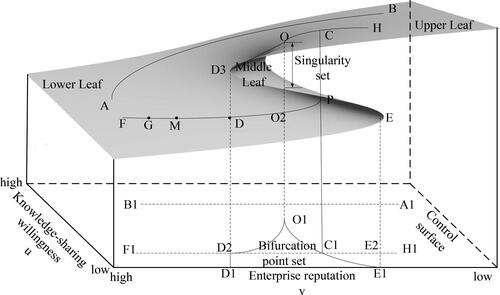
As shown in , first, enterprises' intellectual property cooperation behavior has two relatively stable states: the noncooperative state, represented by the upper leaf, and cooperative state, represented by the lower leaf. Second, the sets of ‘knowledge-sharing willingness’, and ‘enterprise reputation’,
construct the control surface. Third, the O1D1E1 area is the set of bifurcation points. Among them, curve O1D1 is the initial critical condition for the catastrophe of intellectual property cooperation behavior, and curve O1E1 is the terminal critical condition. Finally, point G is the node that introduces the external enterprises. Point D is the node at which the enterprises' intellectual property cooperation behavior has a catastrophe.
Enterprises' intellectual property cooperation behavior is a gradual process. For instance, Luo and Li (Citation2015) proposed that the process of intellectual property cooperation includes five stages: knowledge matching, partner matching, knowledge integration, knowledge creation, and knowledge-advantage formation. Han et al. (Citation2019) argued that knowledge collaboration behavior includes three stages: collaboration demand, activity, and outcome. From this perspective, enterprises' intellectual property cooperation behavior refers to the generation of cooperation needs in the beginning and the occurrence of cooperative activities in the middle and later periods. Combining , this article contends that enterprises' intellectual property cooperation includes the cooperation strategic planning stage, cooperation system formation stage, cooperation system operation stage, and cooperation profit distribution stage. Specific analysis as follows:
Cooperation strategic planning stage(F→G). The stage mainly shows that enterprises can find promising innovation opportunities through market research. Because of the complexity of the required knowledge, enterprises cannot complete the knowledge innovation process alone by relying on their knowledge stock (Yu et al., Citation2019; Chang et al., Citation2017). The strategy of intellectual property cooperation is helpful for enterprises in eliminating the knowledge gap, making up for knowledge demand, and gaining innovation opportunities. Therefore, point G is seen as a node for enterprises to introduce external enterprises.
Cooperation system formation stage(G→M). After mastering knowledge demand, enterprises can choose cooperation partners with complementary advantages and a willingness to share knowledge from reputable external enterprises. Cooperation partners will establish a standardized and institutionalized intellectual property cooperation system by discussing the depth and breadth of the investment of intellectual property resources. Moreover, stronger knowledge-sharing willingness and trust enable cooperation partners to share their intellectual property resources with each other to engage in cooperative innovation activities and strengthen intellectual property cooperation behavior.
Cooperation system operation stage(M→O). Due to the uncertainty of the environment and the difference of the cooperation partners, at all the stages of intellectual property cooperation, the cooperation behavior may fail before the innovation results are realized because of the difference of cooperation goals and the ineffectiveness of communication, the evolutionary track is represented by curve AB. With the development of cooperation and communication, the cooperation partners actively exchange and gather knowledge resources and then promote the flow of knowledge resources in the cooperation system from cluttered to standardized, which has a significant effect on developing new knowledge. The emergence of new knowledge takes some time to be accepted by the market, so the enterprises' cooperation behavior is still in the lower leaf. In , the evolutionary track of enterprises' intellectual property cooperation behavior is represented by curve MD. With the continuous development of cooperation, innovation outcomes created by cooperation partners provide a unique knowledge foundation for the next higher level of intellectual property cooperation. In addition, the innovation outcomes also provide an opportunity for different enterprises to promote the development of the cooperation system. As shown in , under the influence of control variables, the enterprises' intellectual property cooperation behavior crosses the set of bifurcation points. The set of bifurcation points is the projection of the singularity set on the control surface, which indicates that the intellectual property cooperation behavior has reached the critical point of catastrophe. When the control variables change slightly, the cooperation behavior will jump from the lower leaf O2 point to the upper leaf O point, and the evolutionary track of the catastrophe is the curve MO.
Cooperation profit distribution stage(O→H). The evolutionary track of enterprises' intellectual property cooperation behavior enters the set of bifurcation points, leading to the cooperative behavior jump from the lower leaf to the upper leaf. shows the evolutionary track of cooperation profit, represented by curve OH.
In summary, to promote the long-term and stable development of enterprises' intellectual property cooperation, the key is to effectively prevent the control variables from crossing the set of bifurcation points. According to Formula (2), to analyze the evolutionary track of enterprises' intellectual property cooperation behavior, the parameters
should be computed. However, knowledge-sharing willingness and enterprise reputation are often expressed in fuzzy language in practice, and it is difficult to describe their numerical value and direction of change. Therefore, this article introduces the qualitative simulation algorithm that can model fuzzy information. Finally, the model parameters can be computed through qualitative simulation.
3. Application of QSIM algorithm
The basic idea of the QSIM algorithm is first to describe the meaning of each variable with a set of symbols and determine the value of each variable at time according to an orderly landmark value. Then, all the subsequent behavior states can be transformed according to the general function state table. Next, the nonconforming data are deleted according to the actual research needs and then form a new state set. Finally, by comparing the new state set with the real behavior state reflected by the actual survey data, the parameters of the catastrophe model can be obtained (Kuipers, Citation1986).
3.1. Definition of variables
According to the definition of the QSIM algorithm, can be described as
Among them,
represents the landmarks, and
represents the direction of the landmarks. Therefore, this article uses
to define ‘knowledge-sharing willingness’,
‘enterprise reputation’,
and enterprises' intellectual property cooperation behavior,
as follows:
The direction of landmarks is as follows:
3.2. Description of variables value
cannot only divide the variables of the catastrophe model into several significant landmarks and represent different behavior states but also participate in numerical calculations after fuzzy arithmetic algorithm processing (Kuipers, Citation1986). Based on the four stages of intellectual property cooperation behavior, the landmark of each variable is shown in .
Therefore, the fuzzy values are shown in and .
Table 1. The fuzzy value of
Table 2. The fuzzy value of and
Based on the above and with combining Formula (2), the catastrophe model of enterprises' intellectual property cooperation behavior can be described as
(5)
(5)
4. Empirical study and comparative analysis
4.1. Empirical study
4.1.1. Data collection
We choose the enterprises that belong to Chinese high-tech enterprises as our research target for two reasons. First, Chinese high-tech enterprises are knowledge-intensive and technology-intensive. Second, Chinese high-tech enterprises represent advanced technologies in China and engage in frequent knowledge innovation behavior. We selected 33 high-tech enterprises with experience in intellectual property cooperation activities in Heilongjiang Province, China. Then, the enterprise managers were asked to answer questions about intellectual property cooperation strategy planning, cooperation system formation, cooperation system operation, and cooperation profit distribution based on questionnaires survey and on-spot interview. To ensure the quality of the questionnaires, the respondents were required to discuss and confirm all intellectual property cooperation activities that enterprises maintain for at least one year before completing the questionnaires. A total of 510 questionnaires were distributed. This article collected 445 valid questionnaires after removing invalid questionnaires, and the effective rate of response was 87.25%. The descriptive statistics of the 445 respondents show that 17.01% of respondents were aged less than 30, 38.76% of respondents were aged between 30 and 40, and 44.23% of respondents were aged greater than 40. The education levels of the respondents were Bachelor’s (8.59%), Master’s (72.13%), and Ph.D. (19.28%). Approximately 10.59% of respondents had between 0 and 5 years of work experience, 62.17% of respondents had between 5 and 10 years of experience, and 62.17% of respondents had more than 10 years of experience. The positions of the respondents were base-level managers (36.79%), middle-level managers (27.85%), and senior-level managers (35.36%).
4.1.2. Reliability analysis
To ensure the effectiveness of the empirical study, all the questionnaire items come from mature scales. Among them, knowledge-sharing willingness (knowledge-contribute willingness and knowledge-acquire willingness) was measured by 10 items adapted from Bart and De Ridder, (Citation2004). Enterprise reputation (emotional reputation, cognitive reputation, and fair-trade reputation) was measured by 12 items adapted from Schwaiger (Citation2004). A five-point Likert scale was used to measure all variables. This article applied Cronbach's α to examine the reliability of the scale, as shown in .
Table 3. Reliability test of the antecedent variables.
As shown in , we calculated Cronbach's α, which ranged from 0.701 to 0.836, suggesting that the scale possesses high reliability. Based on the results, it was found that enterprise managers pay increasing attention to the search and acquire external knowledge, which is beneficial for enterprises to facilitate intellectual property cooperation behavior. From the perspective of the willingness to share knowledge, the occurrence of intellectual property cooperation behavior makes managers have a strong willingness to acquire knowledge. From the perspective of enterprise reputation, the occurrence of intellectual property cooperation behavior makes managers have a strong cognitive reputation and fair-trade reputation. However, because of the uncertainty of intellectual property cooperation innovation outcomes and the inequality of intellectual property cooperation profits, cooperation partners lose their reciprocal trust and enthusiasm to participate in cooperation activities. The lack of trust and enthusiasm among cooperation partners affects the formation of a willingness to contribute knowledge and emotional reputation, which ultimately affects the stability of intellectual property cooperation. According to the previous analysis and based on our analysis of the survey data, we contend that the stable development of intellectual property cooperation depends on a higher willingness to share knowledge and a higher enterprise reputation. Under a fiercely competitive external environment, on the one hand, cooperation partners cannot share all the knowledge resources in the process of intellectual property cooperation, which leads to a lack of knowledge-sharing willingness among cooperation partners. The lack of willingness to share knowledge affects the realization of disruptive cooperation outcomes. On the other hand, the reputation gap among cooperation partners leads to a decrease in the quality of the cooperative relationship. The adjustment of the enterprise reputation exists in lag, thereby affecting the trust level among cooperation partners.
Using sample data to master the psychological perception and behavior decisions of enterprises' managers under specific situations. Then, during the catastrophe phenomenon occurs in enterprises' intellectual property cooperation behavior, the possible state of the knowledge-sharing willingness and enterprise reputation can be extracted from the sample data. For example, this article found that when managers believe their partners' knowledge-sharing willingness is lower and there is no substantial intellectual property cooperation between cooperation partners in the cooperation system operation stage. Then, the managers' knowledge-sharing willingness also decline rapidly and tend to make behavior decisions to terminate the intellectual property cooperation relationship. The corresponding qualitative state is or
Therefore, we can ensure that the qualitative state of knowledge-sharing willingness and enterprise reputation that result in the catastrophic phenomenon of enterprises' intellectual property cooperation behavior at time based on the sample data, as shown in .
Table 4. Extraction of empirical sample.
4.1.3. Numerical results
Choose a group from and use the QSIM algorithm for computation.
Step 1. According to the General Function State Transition rule in , the subsequent evolutionary state of enterprises' intellectual property cooperation behavior can be calculated at time (Garg & Kaur, Citation2020).
Table 5. General function state transition.
Next, according to filtering rules 1 and 2, the state that does not accord with the management strategy of enterprises can be filtered (Kuipers, Citation1986).
Rule 1: When the control variables cross the set of bifurcation points, a catastrophic phenomenon will appear in intellectual property cooperation.
Rule 2: Once a catastrophic phenomenon occurs in intellectual property cooperation, it jumps to the opposite behavior surface.
Finally, as shown in Formula (6), six kinds of subsequent states of enterprises' intellectual property cooperation can be obtained.
(6)
(6)
Step 2. The values derived from the sample extraction are equal to those derived from the QSIM algorithm
(Hu & Xia, Citation2015).
Formula (6) is taken as an example.
The fuzzy values of
can be obtained from and .
(7)
(7)
Combining Formulas (5) and (7), the catastrophe model can be obtained as Formula (8):
(8)
(8)
Step 3. According to the fuzzy arithmetic algorithm in , the corresponding fuzzy value can be calculated, and the parameters can be calculated according to Formula (9), fuzzy value distance (Shen & Leitch, Citation1993).
(9)
(9)
Table 6. Fuzzy arithmetic algorithm.
According to , the fuzzy value can be obtained as Formula (10)
(10)
(10)
The fuzzy values of the remaining
in Formula (6) can be obtained by repeating the above steps (Hu & Xia, Citation2015).
The fuzzy values of the 4 possible results
of sample data
can be obtained at time
and the average value
of
can also be computed, which is expressed in Formula (11).
(11)
(11)
The distance of 6 groups of fuzzy values
can be obtained by pairing the obtained fuzzy values randomly, as shown in Formula (12) (Zhao et al., Citation2016).
(12)
(12)
The mean value of
can be obtained in simulation. Let
be included in Formula (2). The catastrophe model of enterprises' intellectual property cooperation behavior can be obtained as shown in .
As shown in , enterprises' intellectual property cooperation behavior has obvious catastrophic characteristics, which supports the catastrophic model of intellectual property cooperation behavior.
4.2. Comparative analysis
In order to analyze the feasibility of the combination of QSIM, fuzzy arithmetic algorithm and simulation, a comparative analysis was performed by using the traditional QSIM to analyze enterprises' intellectual property cooperation behavior (Liu & Gu, Citation2011). The results of enterprises' intellectual property cooperation were depicted in Formula (13).
(13)
(13)
It clear that QSIM, fuzzy arithmetic algorithm and simulation in contrast to traditional QSIM, the same subsequent states were acquired. Moreover, the combination of QSIM, fuzzy arithmetic algorithm and simulation can compute the unknown parameters of catastrophe model in order to simulate the evolutionary track of enterprises' intellectual property cooperation behavior in different stages. In our next research, the QSIM shall be combined with other simulation algorithms.
4.3. Long-term and short-term equilibrium of enterprises' intellectual property cooperation behavior
This article assumes that the initial state and evolutionary direction of enterprise reputation and enterprises' intellectual property cooperation behavior are identical, but the knowledge-sharing willingness is different. It then examines the long-term and short-term effects of various initial states of knowledge-sharing willingness on the evolutionary outcomes of enterprises' intellectual property cooperation behavior.
4.3.1. Short-term equilibrium
illustrates the simulation result of while depicts the simulation result of
As illustrated in , when the intellectual property cooperation emerged 3 catastrophic behaviors, including 2 noncooperative behaviors. Comparably, as depicted in , when
the intellectual property cooperation emerged 4 catastrophic behaviors, including 3 noncooperative behaviors. These findings indicate that an enterprise's initial knowledge-sharing willingness influences its intellectual property cooperation behavior. Thus, during the stage of cooperation system formation, cooperation partners should have a clear understanding of each other's knowledge gaps and knowledge stock. They can build mutual trust by convening cooperation forums and then increasing their knowledge-sharing willingness.
4.3.2. Long-term equilibrium
shows the simulation result of while provides the simulation result of
As shown in , when the intellectual property cooperation emerged 4 catastrophic behaviors, including 3 noncooperative behaviors. Comparably, as provided in , when
the intellectual property cooperation emerged 5 catastrophic behaviors, including 4 noncooperative behaviors. The statistical results indicate that cooperation partners with a high initial knowledge-sharing willingness exhibit fewer noncooperative behaviors than cooperation partners with a low initial knowledge-sharing willingness. Meanwhile, in the long-term, the frequency of catastrophic behaviors is higher than in the short-term. Therefore, in the long-term, during intellectual property cooperation, cooperation partners should do everything possible to foster conditions conducive to increase knowledge-sharing willingness. By increasing the efficiency of knowledge flow and sharing, cooperation partners can overcome the limitations of their initial attitudes and beliefs about sharing behaviors. Furthermore, the initial cognitive trust between cooperation partners is gradually transformed into emotional trust to increase their knowledge-sharing willingness and then establish a stable cooperative relationship.
Long-term and short-term results indicate that enterprises' intellectual property cooperation behavior is non-linear and appears a sudden change in a period. Specifically, as the knowledge-sharing willingness crosses the set of bifurcation points which causes catastrophic phenomena ( illustrates the enterprises' intellectual property cooperation behavior jumps from +1 to −1).
Similarly, the long-term and short-term results of enterprise reputation also indicate that enterprises' intellectual property cooperation behavior has apparent catastrophic characteristics.
5. Discussions and implications
In order to help managers to make scientific decisions, this article uses the catastrophe model to illustrate the evolutionary track of intellectual property cooperation behavior in the set of bifurcation points, and then propose corresponding suggestions. The specific steps are as follows: First, collect the initial state data and deduce the subsequent state based on . Then, obtain the fuzzy value of the variable according to the qualitative variables evaluated based on fuzzy arithmetic, and the catastrophe model of enterprises' intellectual property cooperation behavior can be obtained by combining Formula (2). Second, the corresponding catastrophe model can be calculated by the fuzzy arithmetic algorithm in . Next, based on Formula (7) and Formula (9), the corresponding equations can be calculated. Then, the parameters of maximum value, minimum value and mean value can be obtained by pairing the obtained equations. Third, let the maximum value, minimum value and mean value be included in Formula (4). Then, the set of bifurcation points can be divided into three behavior areas: warning, critical, and mutation [26]. Last, according to the qualitative variables evaluated based on fuzzy arithmetic, the boundary conditions of different areas can be determined, as shown in . Therefore, to put forward the control strategies, it is necessary to analyze the force of knowledge-sharing willingness and enterprise reputation on the stability of intellectual property cooperation behavior in different behavior areas.
5.1. The analysis of warning area
When the enterprises' intellectual property cooperation behavior will cross warning area. The cooperation behavior may appear catastrophic phenomenon. Therefore, enterprises need take measures to keep knowledge-sharing willingness or enterprise reputation at a high level to prevent catastrophic phenomenon.
When the impact of reduced knowledge-sharing willingness,
on the stability of intellectual property cooperation behavior,
is shown in .
In , enterprises' intellectual property cooperation behavior changes continuously. This means that a decrease in knowledge-sharing willingness, will not directly lead to a stable state of enterprises' intellectual property cooperation behavior,
toward noncooperative. At the same time,
shows that with the decrease in knowledge-sharing willingness, the fluctuation of enterprises' intellectual property cooperation behavior decreases. Based on the above analysis results, in the warning area, the improvement of enterprises' knowledge-sharing willingness has little effect on improving the cooperation relationship among enterprises.
When the impact of reduced enterprise reputation,
on the stability of intellectual property cooperation behavior,
is shown in .
shows that when the change in enterprises' intellectual property cooperation behavior,
is nonlinear. Moreover, with the decrease of enterprise reputation,
the intellectual property cooperation behavior,
will jump from the lower leaf to the upper leaf.
Comparing and , enterprise reputation plays a decisive role in the evolution of intellectual property cooperation behavior in the warning area. Due to the different abilities of cooperation partners to absorb knowledge resources, when one enterprise internalizes the knowledge of the cooperation system into its own and creates knowledge value that is greater than the cooperation value, it leads to the enterprise manager engaging in opportunistic behavior, and thus reduces credit and reputation among cooperation partners. Related studies show that the cultivation and maintenance of enterprise reputation not only needs the guarantee of an enterprise system but also needs the appropriate enterprise environment (Martín de Castro et al., Citation2006; Boonlert, Citation2017). First, cooperation partners should constantly strengthen the construction of contractual relationships and ensure their role transformation (knowledge sender and knowledge receiver) in the process of cooperation. Second, cooperation partners can establish an all-round and multichannel cooperation mode, thus reducing their concern about opportunistic behavior. Moreover, cooperation partners can share and exchange their unique knowledge resources by coordinating the task allocation of cooperation partners in the process of intellectual property cooperation. Cooperation partners should create a cooperative atmosphere of mutual encouragement and mutual understanding. Finally, enterprises should create a culture that maintains the enterprise's reputation. Enterprises can develop a warm and comfortable working environment and provide fair promotion opportunities, thereby enhancing enterprises' competitiveness.
5.2. The analysis of critical area
When enterprises' intellectual property cooperation behavior had cross critical area. Enterprises should immediately take measures to restore the intellectual property cooperation behavior to cooperative behavior surface.
When the impact of reduced knowledge-sharing willingness,
on the stability of intellectual property cooperation behavior,
is shown in .
As shown in , when the decrease in knowledge-sharing willingness,
leads to a cooperative behavior jump from the lower surface to the upper surface.
When the impact of reduced enterprise reputation,
on the stability of intellectual property cooperation behavior,
is shown in .
As shown in , enterprises' intellectual property cooperation behavior, changes continuously, and a catastrophic phenomenon does not occur.
shows that with the decrease in enterprise reputation, the fluctuation of intellectual property cooperation behavior decreases, which means that the promotion of enterprise reputation has little effect on the stability of intellectual property cooperation behavior.
Comparing and , knowledge-sharing willingness plays a decisive role in the stability of enterprises' intellectual property cooperation behavior in critical areas. The development of new knowledge not only meets the diversified and individualized needs of consumers but also leads to the direction of knowledge innovation. According to cooperation-competition theory, the motive force of system progress comes from the cooperation and competition of each subsystem. Because the occurrence of new knowledge is accompanied by competition, cooperation partners are unwilling to share knowledge, reduce communication frequency, or even hide knowledge intentionally for their market position. Therefore, we should pay attention to the influence of the willingness to share knowledge on the stability of intellectual property cooperation behavior in critical areas.
First, cooperation partners can build a knowledge-sharing database, which is helpful for cooperation partners to store and search for knowledge resources. A knowledge-sharing database is also good for cooperation partners to identify and acquire valuable knowledge resources, which enhances the knowledge-sharing willingness of cooperation partners. Second, cooperation partners should create a warm communication environment to reduce knowledge-hiding behavior, such as brainstorming or writing work-diaries. Third, cooperation partners can carry out cooperation performance review meetings frequently. Review meetings are favorable for cooperation partners to understand the cooperation value and the cooperation standard in time so that they can take measures to promote cooperative relationships. Finally, cooperation partners can carry out conflict management training activities within enterprises. The activities train employees to focus on the content of different opinions in the knowledge sharing process, avoid the conflict of relations, and finally affect the stable development of enterprises' intellectual property cooperation.
5.3. The analysis of mutation area
When the catastrophic phenomenon appears in enterprises' intellectual property cooperation behavior, enterprises must expend more effort to return to the cooperative behavior surface. First, recruiting employees with professional knowledge and talent enables enterprises to form different knowledge advantages to attract other cooperation partners. Second, establishing an incentive mechanism for knowledge sharing within enterprises will increase the willingness of employees to share knowledge. Rewards within a moderate range were given to employees, which is conducive to enhancing the innovation capability of enterprises. Finally, according to feedback from the market, enterprises can analyze differentiated and personalized knowledge demand. After analyzing the knowledge gap of the enterprises, enterprises can choose other cooperation partners with a good reputation and knowledge-sharing willingness based on the knowledge gap to carry out a new round of intellectual property cooperation behavior.
6. Conclusions
The main conclusions of this article are as follows:
Knowledge-sharing willingness and enterprise reputation are the antecedent variables that affect the stable state of enterprises' intellectual property cooperation behavior. Among them, knowledge-sharing willingness affects intellectual property cooperation behavior through cognitive processes, and enterprise reputation affects intellectual property cooperation behavior through emotional processes. Under the influence of knowledge-sharing willingness and enterprise reputation, enterprises' intellectual property cooperation behavior will jump from a cooperative surface to a noncooperative surface.
The intellectual property cooperation process mainly includes four stages: cooperation strategy planning, cooperation system formation, cooperation system operation, and cooperation profit distribution, in which enterprises' intellectual property cooperation behavior does not have a catastrophe in the stage of cooperation strategy planning and cooperation system formation. The evolutionary track of enterprises' intellectual property cooperation behavior will cross the set of bifurcation points and thus jump from cooperative surface to noncooperative surface in the stage of cooperation system operation and finally affect the stable state of intellectual property cooperation behavior in the cooperation profit distribution stage.
The set of bifurcation points can be divided into warning, critical, and mutation behavior areas. In the warning area, the influence of enterprise reputation on the stability of intellectual property cooperation behavior is greater than that of knowledge-sharing willingness. In critical areas, the influence of knowledge-sharing willingness on the stability of intellectual property cooperation behavior is greater than that of enterprise reputation. In the mutation area, the intellectual property cooperation behavior crosses the set of bifurcation points, which makes it catastrophic, and finally moves the stable state of intellectual property cooperation toward noncooperative.
Despite the promising outcomes of intellectual property cooperation behavior presented by this article, the proposed model also has some limitations. The proposed model has only considered the impact of the characteristics of cooperation partners on the stability of intellectual property cooperation. However, the external environment of cooperation system can also affect the evolutionary track of enterprises' intellectual property cooperation behavior. In future research, we would be interesting to add these variables to the model. Moreover, multi-agent simulation and complex network analysis are needed to verify and support this article.
Author's contributions
Xin Kang: Conceptualization, Funding acquisition, Software, Resources, Data curation, Supervision, Writing-review & editing;
Danni Zhao: Methodology, Software, Visualization, Supervision, Roles/Writing-original draft;
Zaoli Yang: Formal analysis, Investigation, Methodology, Software, Visualization, Roles/Writing - original draft.
Disclosure statement
The authors declare that they have no conflict of interest.
Data availability
Not applicable
Additional information
Funding
References
- Boonlert, J. (2017). The impact of corporate social responsibility on firm value: an application of structural equation modelling. International Journal of Business Governance and Ethics, 12(4), 306–329.
- Bart, V. D. H., & De Ridder, J. A. (2004). Knowledge sharing in context: The influence of organizational commitment, communication climate and CMC use on knowledge sharing. Journal of Knowledge Management, 8(6), 117–130. https://doi.org/10.1108/13673270410567675
- Bryhinets, O., Shapoval, R., Bakhaieva, A., Pchelin, V., & Fomenko, A. (2021). Problems of intellectual property in the national security system of the country. Entrepreneurship and Sustainability Issues, 8(3), 471–486. https://doi.org/10.9770/jesi.2021.8.3(30)
- Chang, W. J., Liao, S. H., & Wu, T. T. (2017). Relationships among organizational culture, knowledge sharing, and innovation capability: A case of the automobile industry in Taiwan. Knowledge Management Research and Practice, 15(3), 471–490. https://doi.org/10.1057/s41275-016-0042-6
- Fang, W., Cheng, P., & Li, Z. (2019). Drivers and strategies match the “civil-involved military” knowledge transfer process-A perspective of civil-military integration. Journal of Beijing Institute of Technology, 21(4), 127–136.
- Guo, R., Cheng, X., & Li, C. (2018). A research on the dynamics of IP cooperation in collaborative innovation enterprises. Science Research Management, 39(11), 107–115.
- Gao, S., Guo, Y., Chen, J., & Lin, L. (2016). Factors affecting the performance of knowledge collaboration in virtual team based on capital appreciation. Information Technology and Management, 17(2), 119–131. https://doi.org/10.1007/s10799-015-0248-y
- Garg, H., & Kaur, G. (2020). Extended TOPSIS method for multi-criteria group decision-making problems under cubic intuitionistic fuzzy environment. Scientia Iranica, 27(1), 396–410.
- Martín de Castro, G., López, J. E. N., & Sáez, P. L. (2006). Business and social reputation: Exploring the concept and main dimensions of corporate reputation. Journal of Business Ethics, 63(4), 361–370. https://doi.org/10.1007/s10551-005-3244-z
- Huang, Q., Davison, R. M., & Gu, J. (2011). The impact of trust, guanxi orientation and face on the intention of Chinese employees and managers to engage in peer-to-peer tacit and explicit knowledge sharing. Information Systems Journal, 21(6), 557–577. https://doi.org/10.1111/j.1365-2575.2010.00361.x
- Han, C., Tong, Z., & Liu, X. (2019). The construction of knowledge collaboration behavior model of industrial cluster innovation in complex dynamic environment. Science & Technology Progress and Policy, 36(9), 69–76.
- Hu, B., & Xia, N. (2015). Cusp catastrophe model for sudden changes in a person's behavior. Information Sciences, 294, 489–512. https://doi.org/10.1016/j.ins.2014.09.055
- Javed, M., Rashid, M. A., Hussain, G., & Ali, H. Y. (2020). The effects of corporate social responsibility on corporate reputation and firm financial performance: Moderating role of responsible leadership. Corporate Social Responsibility and Environmental Management, 27(3), 1395–1409. https://doi.org/10.1002/csr.1892
- Kuipers, B. J. (1986). Qualitative simulation. Artificial Intelligence, 29(3), 289–338. https://doi.org/10.1016/0004-3702(86)90073-1
- Liu, Y., & Gu, J. (2011). Study on the group behavior of public opinion based on QSIM algorithm. Business Review, 23(9), 86–92.
- Luo, Q., & Li, C. (2015). Study on the relationships between collaborative innovation and intellectual property cooperation. Journal of Modern Information, 35(9), 44–48 + 55.
- Lekhawipat, W., Wei, Y. H., & Lin, C. (2018). How internal attributions affect knowledge sharing behavior. Journal of Knowledge Management, 22(4), 867–886. https://doi.org/10.1108/JKM-02-2017-0081
- Shen, Q., & Leitch, R. (1993). Fuzzy qualitative simulation. IEEE Transactions on Systems, Man, and Cybernetics, 23(4), 1038–1061. https://doi.org/10.1109/21.247887
- Schwaiger, M. (2004). Components and parameters of corporate reputation-An empirical study. Schmalenbach Business Review, 56(1), 46–71. https://doi.org/10.1007/BF03396685
- Samson, D., Terziovski, M., & Lai, A. (2005). Intellectual property strategy and business strategy: Connections through innovation strategy. Intellectual Property Research Institute of Australia.
- Teece, D. J. (2000). Strategies for managing knowledge assets: The role of firm structure and industrial context. Long Range Planning, 33(1), 35–54. https://doi.org/10.1016/S0024-6301(99)00117-X
- Thom, R. (1975). Structural stability and morphogenesis: An outline of a general theory of models. Addison-Wesley.
- Tang, G., Zhao, X., & Meng, D. (2014). Study on the framework of enterprise open intellectual property strategy. Science of Science and Management of S. & T, 35(2), 11–20.
- Wang, P. (2017). Evolutionary game analysis on knowledge sharing of failures among members of enterprise alliance. Information Studies: Theory & Application, 40(8), 112–116.
- Wang, R. (2014). Qualitative simulation research on evaluating performance of individual ks for SME. Journal of Industrial Technological Economics, 33(8), 51–57.
- Wang, G., & Xu, L. (2019). Game analysis of strategy evolution of incubating enterprises in incubation network. Systems Engineering, 37(5), 21–30.
- Yao, H., Mao, X., & Jin, H. (2020). Research on evolutionary game of knowledge sharing in virtual community considering platform influencing factors. Operations Research and Management Science, 29(12), 82–88.
- Yu, H., Shang, Y., Wang, N., & Ma, Z. (2019). The mediating effect of decision quality on knowledge management and firm performance for Chinese entrepreneurs: An empirical study. Sustainability, 11(13), 3660. https://doi.org/10.3390/su11133660
- Yang, Z., Shi, Y., & Li, Y. (2018). Analysis of intellectual property cooperation behavior and its simulation under two types of scenarios using evolutionary game theory. Computers & Industrial Engineering, 125, 739–750. https://doi.org/10.1016/j.cie.2018.02.040
- Yang, Z., Zhao, H., & Liu, X. (2018). Technologic strategic alliances' driving, cooperation optimizing and stability of strategic alliance. Studies in Science of Science, 36(4), 691–700.
- Zhao, X., Hu, B., & Xia, N. (2016). Qualitative simulation of employee turnover behavior based on catastrophe theory: The evidence from demission in the period of China's economic transformation. Journal of Systems and Management, 25(4), 691–704.
- Zhang, R., Zhou, W., & Chen, Q. (2020). An analysis of evolutionary game between organizational trust and knowledge sharing. Science Research Management, 41(10), 210–217.


